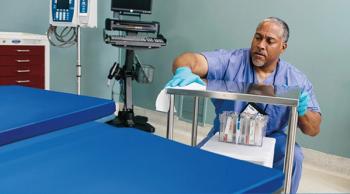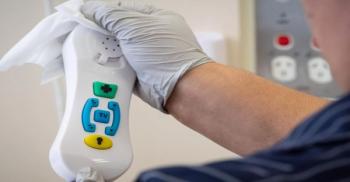
Anthony Harris, MD, MBA, MPH: “Really now it’s all about testing. How do we test? What scale do we test with? And, you know, what are the steps toward getting that access to the testing levels that we need necessary to mitigate risk?”

Anthony Harris, MD, MBA, MPH: “Really now it’s all about testing. How do we test? What scale do we test with? And, you know, what are the steps toward getting that access to the testing levels that we need necessary to mitigate risk?”

Sharon Ward-Fore, MS, MT(ASCP), CIC: “Although EVS is in charge of the cleaning process infection preventionists work carefully with them to make sure the process is followed by auditing it frequently. And both sides provide feedback to each other just to make sure everything follows best practices.”

Investigators found SARS-CoV-2 "on various hospital objects, and these surfaces can be sources of nosocomial transmission via direct contact. Therefore, our findings provide an important basis for justification of strict contact precaution.”

Mark Beeston: “Infection preventionists are a key component and a key gatekeeper in UVC technology and where it goes. Their recommendations are key and as clinical nurse leaders may be looking at providing additional tools, they want to consult with their infection prevention team.”

Charles Gerba, PhD: “I really think that in the future, what you really need is a specialist in infection control who understands both the environmental health services and also the professional staff that deals with the patients.”

The swiftness and severity of the COVID-19 spread meant some hospitals were scrambling to adjust. Environmental services often led the way.

Sometimes the surfaces that are deemed easiest to keep clean in a hospital pediatric ward wind up being the most contaminated after cleaning. Preconceived notions may play a part.

Disinfectant wipes became all the rage when coronavirus disease 2019 (COVID-19) struck but a study in the works says there's a dearth of knowledge about just how they should be used.

Sharon Ward-Fore, MS, MT(ASCP), CIC: “It is a collaboration, and I think the most successful environmental services department has an infection preventionist who really enjoys working with EVS.”


The use of disinfectant wipes in hospitals is increasing; these wipes should be able to inactivate microorganisms including viruses on environmental surfaces and to prevent their transfer to clean areas.

The aim of this study by Ling and Hui (2019) was to establish a set of assessment methods suitable for evaluating the complex indoor environment of hospital wards and to ascertain the composition of bacteria and microbial ecology of hospital wards.




Exploring the importance of disinfecting non-critical and environmental surfaces.

This webinar will explain the imperatives for infection preventionists, environmental services professionals, and other healthcare stakeholders.







